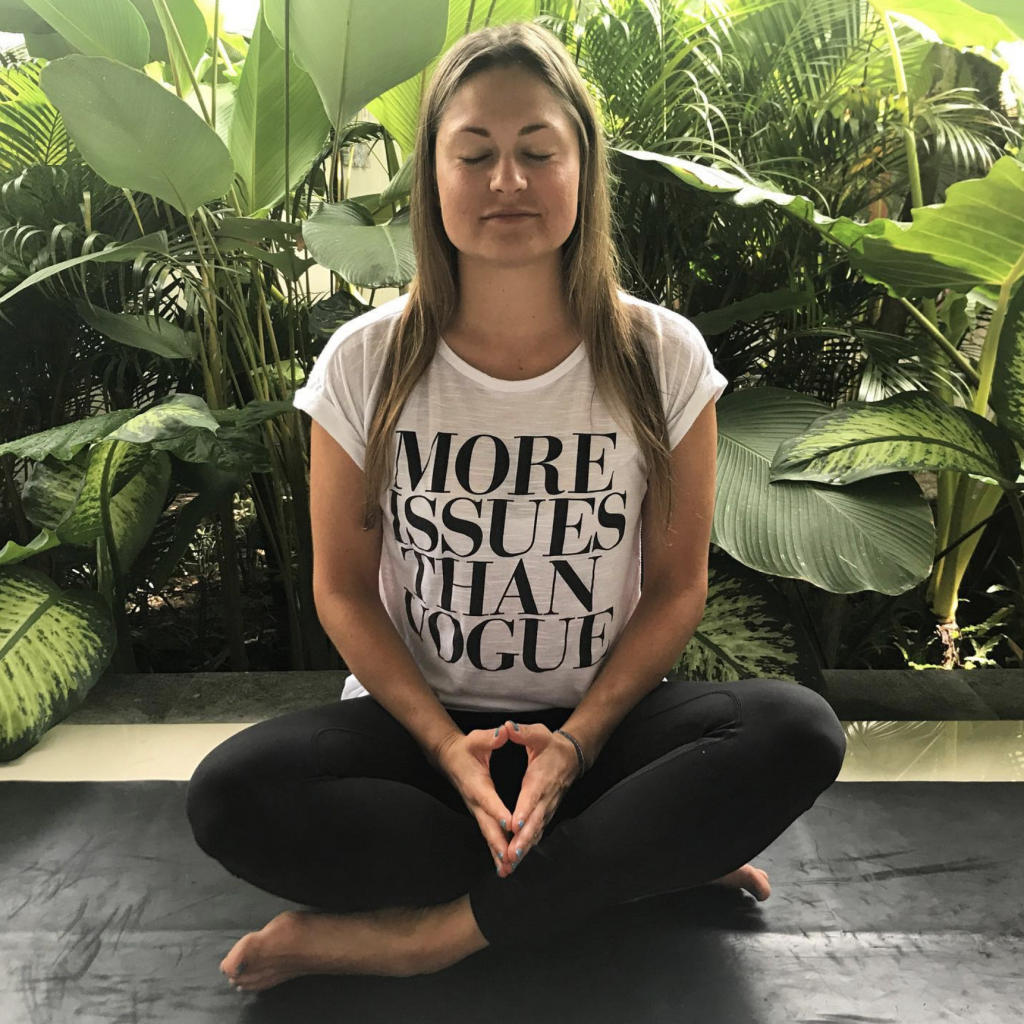Listen to this episode here ![]()
I could not be more excited for this episode as we’re focusing on how to put your mental health first.
My guest today is Amanda White. She’s a licensed therapist and the founder of a therapy practice in Philadelphia called Therapy for Women’s Center.
She’s also been featured in Forbes, Washington Post shape, Women’s Health magazine. Plus, she’s also the author of the book “Not Drinking Tonight: A Guide to Creating a Sober Life You Love”.
However, you are more likely to recognize her from her wildly popular Instagram account, @therapyforwomen.
I mentioned previously that the show will be expanding to cover more areas outside of business.
This will help you create a life by your own design, and we’re starting with putting your mental health first.

How to Put Your Mental Health First with Amanda White
Something I shared in the last episode of Her Life By Design was my difficulty sitting with my feelings. This inability to truly embrace my feelings ultimately led me to numbing behaviors like drinking.
Amanda joins us today to discuss how shame and trauma can contribute to our numbing behaviors. She also shares tools to help us better regulate our nervous system and emotions.
So let’s dive right into the discussion, starting with…
Understanding and Identifying Numbing Behaviors
Numbing behaviors don’t just show up in the forms of addiction, substance abuse, or alcoholism. In fact, they can show up in other forms of behaviors ranging from shopping, eating disorders, unhealthy relationships, and more.
Amanda compares these behaviors to icebergs.
“All those numbing behaviors really are only there because of what’s going on under the iceberg. And you can’t see 85% of an iceberg.”
So it’s really important to focus on what’s happening under the surface of those visible behaviors.
“If we look under the surface, there’s a lot of times mental health issues, trauma, and shame. It might be your environment. Even genetics that makes you predisposed to it, burnout, lack of social skills, and a lot of us need re-parenting.”
Amanda explains that sometimes, our parents were too “there” for us. Meaning we haven’t learned how to properly do things for ourselves.
In her book, she talks about how “everyone can benefit from learning how to process your emotions, set boundaries, and engage in self-care and mindfulness skills.”
I found this to be especially true in my own sobriety story. Since I had to heal from all the reasons that led to my need to drink in the first place.
Alcohol was my escape from healing and dealing with my feelings. But a lot of people might turn to sex, scrolling on social media, Netflix, and a plethora of other behaviors. They do this to avoid addressing the underlying issue and avoid feeling our feelings.

Tips for Sitting in Our Feelings and Putting Your Mental Health First
Unfortunately, learning to acknowledge our feelings and put our mental health first isn’t something we’re taught to do.
Amanda shares that studies have shown that most people can only identify an average of 5 emotions. That’s an incredibly low number!
And the reason why that matters is “because the more specific you can name your emotions, the more you can actually regulate your emotions.”
One of the first things that you can do to help regulate and sit with your emotions, according to Amanda, is to expand your emotional vocabulary. This could be done by simply learning more words to describe a wider range of emotions.
The second thing you can do is to really think about your emotions, starting with the physiological body sensations that come with an emotion.
For example, you can notice things like your heart racing, chest tightening, and even if you’re breaking a sweat.
Typically, we don’t like feeling these sensations and that’s when we start reaching out for something to numb them out.
“When you chronically avoid how you feel, it just ends up kind of building up over time. And we learn that our emotions are scary, so we don’t learn to trust ourselves.”
So ultimately, slowing down, paying attention, and recognizing these sensations can help you identify and sit in your feelings. This is key since it can help you avoid resorting to your numbing behavior.

How Toxic Positivity Contributes to Numbing Behaviors
If you’re recognizing yourself in this conversation, there might be a societal influence on why we’re not great at feeling our feelings.
Personally, there were many times in my childhood where people around me would say, “you shouldn’t complain because starving people in the world have it worse than you.”
Amanda believes that toxic positivity plays a huge role in why people turn to numbing behaviors.
“I think this idea of trying to force gratitude invalidates our feelings because you can feel grateful for what you have and still honor that.”
At the end of the day, what’s happening all around the world shouldn’t negate from and invalidate your pain.
Toxic positivity can also detract from someone’s experienced trauma. Society has a certain idea or image when it comes to trauma.
However, Amanda says that what really becomes and impact trauma is “if you feel like you had support and you had people that were around you that you could rely on.”
Trauma looks different for everyone.
Tips for Regulating Anxiety and the Nervous System
To bring it back to the topic of numbing behaviors, there’s no denying that a lot of people turn to these vices to regulate and soothe their anxiety and nervous system.
In order to truly regulate your anxiety and nervous system, Amanda suggests recognizing how these behaviors are serving you. Journal about it, get curious about it, and really think about what it’s doing for you.
When you do that, you can start looking at other things that could better soothe and regulate your anxiety and nervous system.
“The truth is, anything that’s a quick fix might be really effective in the short term. But if you chronically ignore your emotions, numb out, or escape them in the long run, you’re never actually processing and working through those emotions.”
What ends up happening when you ignore your emotions for a long period of time, you start to overwhelm yourself and you never truly trust yourself to work your way through an emotion.
When we reach out to our numbing behaviors in moments of difficulty, all we’re doing is putting off the hard work that is dealing with our emotions. And in order for us to properly soothe and regulate your nervous system, Amanda suggests really examining your window of tolerance.
One of Amanda’s favorite ways to remain in that window of tolerance is to get into your body through exercise, cleaning, and simply moving around.

Sobriety, Social Situations, and Putting Your Mental Health First
No matter who you are, taking care of your mental health will greatly and positively impact your quality of life.
Although Amanda and I discuss in detail the specifics of sobriety, navigating through social situations as a newly sober person, and how to identify if drinking has evolved into a more serious issue in your life – this episode is for anyone who wants to learn how to put your mental health first.
Remember, alcohol isn’t the only type of numbing behavior out there. And while we may be focusing on sobriety, the tips and techniques Amanda shares are applicable across the board.
This episode is an invitation for you to look back at things that have happened throughout your life that you might be numbing in some way.
So tune in as Amanda supports you on this journey so you can show up in your life the way you truly want to.
Tune in to this episode by clicking the player above!
A Glance at what we discuss:
- Shame and trauma and how they can lead to numbing behaviors (7:20)
- Tips for feeling your feelings and not running away from them (10:35)
- How toxic positivity can contribute to the inability to feel your feelings (13:20)
- Tips for regulating anxiety and your nervous system (17:07)
- Amanda’s favorite ways of establishing safety within yourself (19:35)
- How to evaluate and renegotiate your relationship with alcohol (23:49)
- Navigating social situations when you’re sober (26:20)
- Some signs to look out for if drinking has evolved into a problem (29:44)
- Addictive behavior patterns that Amanda sees in her clients (36:17)
- Mental health questions rapid-fire with Amanda (38:38)
DROP SOME LOVE IN ITUNES:
If you enjoyed this episode, go ahead and hit SUBSCRIBE. There is a new episode every Wednesday and I would hate for you to miss a thing. Click here to subscribe on iTunes.AND if you are feeling extra generous, take a few seconds to leave Her Life By Design a review on Apple Podcasts. Or post a screenshot on your Stories with some feedback. Hearing what you think about this episode and the podcast as a whole means the WORLD to me. After all, this is all for you. More reviews = more listeners = better guests & content. So all you gotta do is click here to review, click “Ratings and Reviews” and “Write a Review.” I’ll love you forever!




+ show Comments
- Hide Comments
add a comment